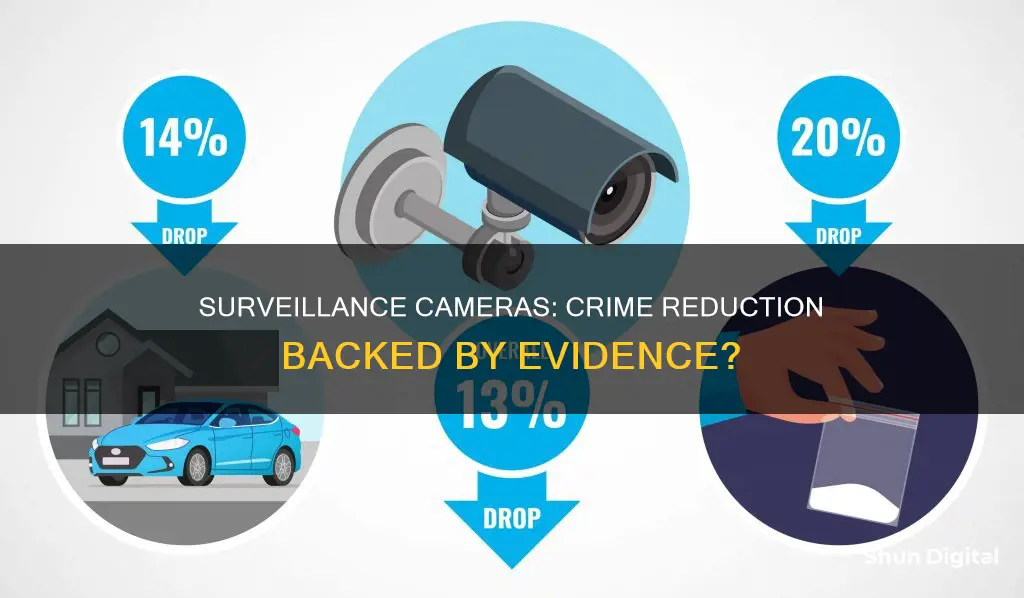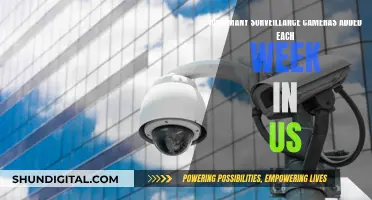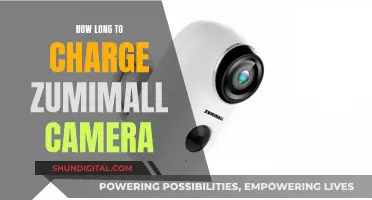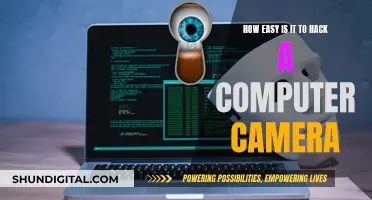
The use of surveillance cameras to prevent and solve crimes is a widely debated topic. While some argue that they are an invasion of privacy, others advocate for their successful use in investigations and their ability to deter criminals. Research on the effectiveness of surveillance cameras in reducing crime has yielded mixed results, with some studies showing a decrease in crime rates and others indicating an increase or no significant change. The impact of surveillance cameras on crime appears to depend on various factors, such as the presence of additional security measures, the type of crime, and the location of the cameras.
| Characteristics | Values |
|---|---|
| Crime reduction | 50% reduction in Orange County, New Jersey |
| Crime reduction | 20% reduction in Montevideo, Uruguay |
| Crime reduction | 30 incidents per month in Baltimore |
| Crime reduction | 12% reduction in Chicago |
| Cost-effectiveness | Montevideo programme: $830 per offence prevented |
| Cost-effectiveness | Montevideo programme: 5 times cheaper than average cost per offence in Uruguay |
| Cost-effectiveness | Baltimore programme: 50 cent return on the dollar |
| Cost-effectiveness | Chicago programme: $4 saved for every $1 spent |
| Effectiveness | More effective in small enclosed areas |
| Effectiveness | More effective in combination with other methods |
| Effectiveness | More effective in preventing vehicle crimes |
| Effectiveness | More effective in preventing property crimes |
| Effectiveness | Less effective in preventing violent crimes |
| Effectiveness | Less effective in open areas or high-traffic areas |
What You'll Learn
- Surveillance cameras are most effective when combined with other crime-reducing methods
- Surveillance cameras do not prevent all crime and are not a foolproof solution
- Surveillance cameras are a valuable tool for solving crimes
- Surveillance cameras can reduce crime in specific areas of a city
- Surveillance cameras are a cost-effective solution for crime reduction

Surveillance cameras are most effective when combined with other crime-reducing methods
The effectiveness of surveillance cameras in reducing crime has been the subject of extensive research and debate. While some studies have found that CCTV cameras can deter and reduce crime, others have shown inconsistent results or even an increase in criminal activity following the installation of cameras. However, there is a consensus that surveillance cameras are most effective when combined with other crime-reducing methods. This multi-layered approach to security can enhance the impact on deterring and preventing criminal activity.
Surveillance cameras, when used in conjunction with improved lighting, can increase the likelihood of detecting and apprehending criminals. Well-lit areas not only act as a deterrent but also improve the quality of video footage, making it easier to identify perpetrators. Additionally, the presence of security guards or police officers actively monitoring the cameras can further enhance the effectiveness of the surveillance system. Their immediate response to any suspicious activity or ongoing crimes can lead to a higher rate of crime prevention and a faster resolution.
In certain contexts, the combination of surveillance cameras with defensible space methods has proven successful. This involves implementing measures such as street closures or barricading in inner-city neighbourhoods to restrict access and create a more controlled environment. By limiting the number of entry and exit points, the area becomes more manageable for surveillance and security personnel, increasing the chances of deterring or apprehending criminals.
The placement of cameras is also a critical factor in their effectiveness. Studies have shown that CCTV is most effective in small enclosed areas, such as parking garages, where the risk of vehicle crimes is high. The concentration of multiple cameras in these targeted areas can significantly reduce the likelihood of crimes occurring. Additionally, the use of actively monitored CCTV cameras in public places has been found to be more successful in preventing crimes than cameras that are not actively monitored.
While surveillance cameras can be a valuable tool in crime reduction, they should not be relied upon as the sole method. The complexity of crime and its varying causes require a multifaceted approach to prevention and deterrence. By combining surveillance cameras with complementary measures, such as improved lighting, security personnel, and environmental design strategies, a more robust and effective security system can be established.
Unlocking Single-Camera Portrait Mode: Unraveling the Mystery
You may want to see also

Surveillance cameras do not prevent all crime and are not a foolproof solution
While surveillance cameras are generally effective in deterring and reducing crime, they do not prevent all types of crime and are not a foolproof solution. Firstly, it is important to note that the effectiveness of security cameras varies depending on the type of crime. Research suggests that CCTV and surveillance cameras are particularly effective in reducing property crimes, such as vehicle crimes and burglaries, especially in enclosed areas like parking garages. On the other hand, surveillance cameras have not been shown to significantly reduce violent crimes.
Additionally, the effectiveness of surveillance cameras is influenced by their implementation and the environment in which they are used. For instance, the placement of cameras, lighting conditions, and the presence of complementary security measures can impact their ability to deter crime. In some cases, the installation of cameras has been associated with an increase in certain types of crimes, indicating that cameras alone may not be sufficient to prevent all criminal activity.
Furthermore, the success of surveillance cameras also depends on their functionality and proper usage. Technical failures, limited coverage, and incorrect positioning can hinder their effectiveness. For example, a study by Queen's University found that camera systems between 2001 and 2003 had 168 technical failures, impacting their ability to capture evidence. Similarly, a case study in Lincoln, Nebraska, showed that cameras did not help identify or deter criminals in a downtown bar street, with 128 assaults occurring within 500 feet of the cameras.
While surveillance cameras can be a valuable tool in crime prevention and solving crimes, they should not be relied upon as a standalone solution. The most effective approach is to use cameras in conjunction with other security measures, such as improved lighting, security guards, and defensible space. Additionally, the successful implementation of surveillance cameras requires considering privacy concerns and ensuring proper training and accountability for law enforcement officers operating the cameras.
How to Handle Camera Tickets in NYC
You may want to see also

Surveillance cameras are a valuable tool for solving crimes
Surveillance cameras are a valuable tool in solving crimes and bringing offenders to justice. They are also a deterrent, as criminals do not want to be seen or recorded. This is supported by a study from the University of North Carolina, which found that 60% of burglars would move on to another target if they saw security cameras.
The use of surveillance cameras has been shown to be effective in several cases. For example, in Orange County, New Jersey, the installation of surveillance cameras resulted in a 50% drop in all types of crime across the city. The police officers involved in the study noted that access to the recordings made it much easier to investigate cases and apprehend and prosecute offenders. In another instance, investigators were able to identify the suspects in the Boston Marathon bombing by reviewing video footage from the city's cameras.
Surveillance cameras have also proven to be a cost-effective way to deter, document, and reduce crime. A study in Montevideo, Uruguay, found a 20% reduction in crime in areas with police-monitored cameras, with no evidence of a displacement effect. The programme was also deemed to offer value for money compared to other security measures. Similarly, in Baltimore and Chicago, the use of cameras was linked to reduced crime, even beyond the areas under camera coverage. The cost savings in Chicago amounted to over four dollars saved for every dollar spent on the technology.
While the effectiveness of surveillance cameras in crime reduction is supported by several studies, it is important to note that their impact is enhanced when combined with other crime-reducing methods such as improved lighting, security guards, and defensible space. Additionally, the use of cameras should be implemented responsibly, addressing privacy issues and ensuring proper training for operating staff.
Exploring Raspberry Pi Camera's TL Mode: What's Special?
You may want to see also

Surveillance cameras can reduce crime in specific areas of a city
The effectiveness of surveillance cameras in reducing crime has been the subject of extensive research and debate. While some studies suggest that CCTV cameras are effective in deterring and reducing certain types of crimes, others indicate mixed results, with some even showing an increase in crime after the installation of cameras. Overall, it seems that the impact of surveillance cameras on crime varies depending on the specific context and area of implementation.
In support of the argument that surveillance cameras can reduce crime in specific areas of a city, several studies provide compelling evidence. For instance, a comprehensive study by the University of North Carolina surveyed 422 imprisoned burglars, finding that 60% of them would search for an alarm system before breaking into a house and would move on to another target if an alarm or camera was present. This suggests that security cameras can act as a significant deterrent to potential offenders.
Furthermore, the Municipal Technical Advisory Service (MTAS) reviewed various papers, articles, and reports and concluded that CCTV cameras are indeed effective in reducing crime, particularly when combined with other measures such as improved lighting, security guards, and defensible space. Their review also found that CCTV was most effective in reducing vehicle crimes, especially in parking garages.
Additionally, surveillance cameras have been credited with notable crime reduction in specific cities. For example, the installation of cameras in Orange County, New Jersey, resulted in a 50% drop in all types of crimes across the city. Similarly, the implementation of camera systems in Baltimore and Chicago led to reduced crime rates, with Chicago experiencing an estimated 12% reduction in crime.
The impact of surveillance cameras is also supported by studies in Montevideo, Uruguay. The introduction of police-monitored cameras in certain areas of the city resulted in a 20% reduction in crime, with no evidence of a displacement effect, suggesting that the cameras effectively deterred criminal activity.
While the aforementioned studies provide evidence for the effectiveness of surveillance cameras in specific areas, it is important to acknowledge that the impact may vary depending on the type of crime. For instance, while CCTV cameras have been shown to reduce property crimes and vehicle crimes, they may have less of an impact on violent crimes or crimes that occur indoors, such as assault and domestic violence.
In conclusion, while there is evidence to suggest that surveillance cameras can reduce crime in specific areas of a city, particularly when combined with other crime-reducing measures, the overall effectiveness is complex and dependent on various factors. More research is needed to fully understand the impact of surveillance cameras on different types of crimes and in varying contexts.
Best Cameras for Cobra Surveillance System Compatibility
You may want to see also

Surveillance cameras are a cost-effective solution for crime reduction
The cost-effectiveness of surveillance cameras as a crime reduction strategy is evident when comparing the costs of the technology to the savings from averted crimes. In Chicago, for instance, the savings from reduced crimes were four times higher than the cost of the camera systems. In Montevideo, the estimated cost per offence prevented was $830, while the cost incurred by the private sector and government per offence in the country was $4,200.
Surveillance cameras are particularly effective in specific contexts, such as parking garages, where they have been shown to reduce vehicle crimes. Additionally, combining cameras with other security measures, such as improved lighting, security guards, and defensible space, further enhances their effectiveness in deterring and reducing crime.
While the impact of surveillance cameras on violent crimes is less clear, they are undoubtedly a valuable tool in solving crimes. Camera footage aids investigations by providing additional leads and securing witness cooperation.
However, it is essential to consider the potential invasion of privacy that comes with the use of surveillance cameras. To address this concern, law enforcement agencies should implement policies that respect privacy, such as avoiding inappropriate views of private areas and documenting and publicizing the guidelines for camera usage.
Game Camera Battery Life: How Long Do They Last?
You may want to see also
Frequently asked questions
There is some evidence to suggest that surveillance cameras can reduce crime, especially when combined with other security measures such as improved lighting, security guards, and defensible space. However, the effects of surveillance cameras on crime vary across different contexts, and more research is needed to fully understand their impact.
Surveillance cameras can act as a deterrent to potential criminals, as they do not want to be seen or recorded committing a crime. Cameras can also aid in the investigation and prosecution of crimes by providing valuable evidence to law enforcement.
Yes, several studies have found a positive correlation between the use of surveillance cameras and a reduction in crime rates. For example, a study in Montevideo, Uruguay, showed a 20% reduction in crime in areas with police-monitored cameras, with no evidence of crime displacement to other areas. Another study in Orange County, New Jersey, showed a 50% drop in all types of crime after the installation of surveillance cameras.
One limitation is that surveillance cameras may not be effective in all types of crime, particularly violent crimes or crimes that occur in indoor or private settings. There are also privacy concerns associated with the use of surveillance cameras, as they can invade personal spaces and potentially be hacked. Additionally, some studies have shown mixed results, with a few even indicating an increase in crime after the installation of cameras.
Surveillance cameras should be used in conjunction with other security measures such as lighting and physical security. It is also important to ensure proper maintenance and functionality of the cameras, as technical failures can render them ineffective. Trained staff should monitor the cameras, and clear policies should govern their use to address privacy concerns and prevent misuse.







